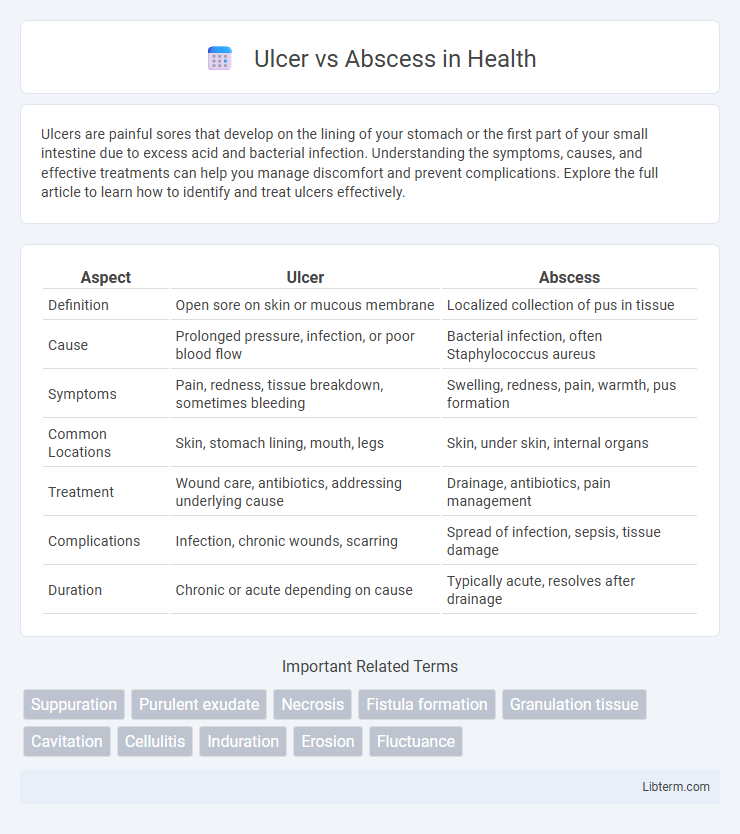Ulcers are painful sores that develop on the lining of your stomach or the first part of your small intestine due to excess acid and bacterial infection. Understanding the symptoms, causes, and effective treatments can help you manage discomfort and prevent complications. Explore the full article to learn how to identify and treat ulcers effectively.
Table of Comparison
| Aspect | Ulcer | Abscess |
|---|---|---|
| Definition | Open sore on skin or mucous membrane | Localized collection of pus in tissue |
| Cause | Prolonged pressure, infection, or poor blood flow | Bacterial infection, often Staphylococcus aureus |
| Symptoms | Pain, redness, tissue breakdown, sometimes bleeding | Swelling, redness, pain, warmth, pus formation |
| Common Locations | Skin, stomach lining, mouth, legs | Skin, under skin, internal organs |
| Treatment | Wound care, antibiotics, addressing underlying cause | Drainage, antibiotics, pain management |
| Complications | Infection, chronic wounds, scarring | Spread of infection, sepsis, tissue damage |
| Duration | Chronic or acute depending on cause | Typically acute, resolves after drainage |
Introduction to Ulcers and Abscesses
Ulcers are open sores on the skin or mucous membranes caused by prolonged tissue breakdown, often resulting from infections, poor circulation, or chronic conditions like diabetes. Abscesses are localized collections of pus formed by the body's immune response to bacterial infections, characterized by swelling, pain, and redness. Both conditions require timely medical evaluation to prevent complications and promote effective healing.
Definition of Ulcer
An ulcer is a localized open sore on the skin or mucous membrane resulting from tissue breakdown and the loss of the surface layer, often caused by infection, inflammation, or poor blood circulation. In contrast, an abscess is a collection of pus that forms inside tissue due to infection, characterized by swelling, redness, and pain. Ulcers typically develop gradually and can become chronic, whereas abscesses usually present as acute, painful lumps requiring drainage.
Definition of Abscess
An abscess is a localized collection of pus caused by a bacterial infection resulting in tissue inflammation and swelling. It typically manifests as a painful, swollen lump filled with pus, often requiring drainage for healing. Unlike ulcers, which are open sores on the skin or mucous membranes, abscesses present as closed pockets of infection beneath the surface.
Key Differences Between Ulcer and Abscess
Ulcers are open sores on the skin or mucous membranes characterized by tissue erosion, often caused by infections, chronic inflammation, or vascular issues, whereas abscesses are localized collections of pus resulting from bacterial infection. Ulcers typically present as flat, painful lesions with a loss of surface tissue, while abscesses manifest as swollen, tender nodules filled with pus and may cause systemic symptoms like fever. Treatment for ulcers focuses on addressing underlying causes and promoting healing, whereas abscesses usually require drainage combined with antibiotics to eradicate the infection.
Causes of Ulcers
Ulcers primarily result from prolonged irritation or damage to the mucous membranes due to factors such as Helicobacter pylori infection, chronic use of nonsteroidal anti-inflammatory drugs (NSAIDs), excessive acid production, or underlying medical conditions like Crohn's disease. In contrast, abscesses are localized collections of pus caused by bacterial infections that lead to tissue necrosis and inflammation. Understanding the distinct etiologies is crucial for targeted treatment strategies in managing ulcers versus abscesses.
Causes of Abscesses
Abscesses are primarily caused by bacterial infections, most commonly Staphylococcus aureus, which trigger an immune response leading to localized pus accumulation. They often develop due to skin trauma, blocked glands, or foreign bodies that allow bacteria to invade deeper tissues. Unlike ulcers, which result from chronic pressure, poor circulation, or underlying diseases, abscesses are acute inflammatory responses to infection.
Symptoms: Ulcer vs Abscess
Ulcer symptoms typically include a persistent open sore with a red or inflamed base, pain, and possible bleeding, often accompanied by a foul odor if infected. Abscess symptoms feature localized swelling, intense pain, warmth, redness, and pus accumulation beneath the skin, often causing fever or fatigue. Differentiating these symptoms is crucial for accurate diagnosis and appropriate treatment of ulcers versus abscesses.
Diagnostic Approaches
Diagnostic approaches for ulcers often involve clinical examination, biopsy, and histopathological analysis to identify the ulcer's underlying cause, such as infection or malignancy. Abscess diagnosis relies heavily on imaging techniques like ultrasound or CT scans to detect the localized pus collection, alongside aspiration for microbiological culture. Both conditions benefit from laboratory tests, but imaging and tissue sampling are critical for precise differentiation and treatment planning.
Treatment Options
Ulcer treatment typically involves wound care, antibiotics if infected, and addressing underlying causes such as poor circulation or infection control. Abscess treatment requires drainage, either through incision or needle aspiration, combined with antibiotics to eradicate the bacterial infection. Choosing the appropriate treatment depends on the diagnosis, severity, and location of the lesion.
Prevention and Management Tips
Ulcer prevention includes maintaining proper hygiene, avoiding excessive use of NSAIDs, and managing underlying conditions like diabetes or infections to reduce tissue breakdown. Abscess management focuses on timely drainage, antibiotic therapy tailored to the causative bacteria, and maintaining wound cleanliness to prevent spread and recurrence. Both conditions benefit from adequate nutrition, regular medical monitoring, and prompt treatment to enhance healing and minimize complications.
Ulcer Infographic

 libterm.com
libterm.com